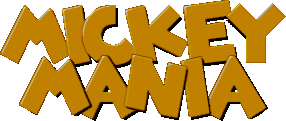Mickey Mania
| Mickey Mania | |||
|---|---|---|---|
| Studio | Traveller's Tales | ||
| Publisher | Sony Imagesoft | ||
| Senior Developer | Jon Burton , Andy Ingram , David Jaffe | ||
| Erstveröffent- lichung |
Sega Mega Drive October 1994 March 31, 1995 April 1, 1995 April 1, 1995 April 25, 1995 SNES October 1994 March 31, 1995 April 1, 1995 April 1, 1995 Sega Mega-CD 1994 1994 1995 Sony PlayStation 1996 1996, 2001 |
||
| platform | Sega Mega Drive / Sega Genesis , Sega Mega-CD , Super Nintendo Entertainment System / Super Famicom , Sony PlayStation | ||
| genre | Side scrolling platformer | ||
| Subject | Time travel | ||
| Game mode | Single player | ||
| control | Gamepad | ||
| medium | Module , CD-ROM | ||
| language | English | ||
| Age rating | |||
| information | A remake of the game was released on Sony's PlayStation in 1996 as Mickey's Wild Adventure . | ||
Mickey Mania: The Timeless Adventures of Mickey Mouse is a 2D - Jump 'n' Run for Sega Mega Drive , Sega CD and Nintendo's SNES . The player plays himself in the role of Mickey Mouse through different side scrolling levels, which all represent a classic Mickey Mouse cartoon from 1928 to 1990 and are designed according to these. The game later appeared in Europe and Australia for Sony's PlayStation as Mickey's Wild Adventure . It's also the first game video game designer David Jaffe was involved in.
development
The game was developed in collaboration between Disney Software and the publisher Sony Imagesoft and was first presented on June 23, 1994 at the Summer Consumer Electronics Show in Chicago. Although Disney characters had previously appeared in video games, excerpts from Disney cartoons were transferred to a game for the first time for Mickey Mania. Disney animators created over 1,500 cels exclusively for the game.
Originally, Mickey Mania was to appear in 1993 for Mickey Mouse's 65th birthday. However, since this would have only meant 6 months of production time, this background was discarded and more focused on the concept of making Mickey travel back in time through his own cartoons. The game is a tribute to Mickey's entire cartoon career. It was released in 1994, the year following Mickey's 65th birthday.
Game mechanics
As Mickey Mouse you have to fight your way through different levels while defeating opponents by throwing marbles or jumping on the head and solving puzzles in order to remove obstacles and thus be able to advance the path. At the end of each level you meet the Mickey Mouse of the respective cartoon.
Level environments
The levels are based on the following Classic Mickey Mouse cartoons :
- Steamboat Willie (1928)
- The mad doctor ( The Mad Doctor , 1933)
- Mickys Platzkonzert ( The Band Concert , 1935) - Bonus level in the Mega-Drive and Mega-CD version
- The Moose Hunters ( Moose Hunters , 1937)
- Lonely spirits ( Lonesome Ghosts , 1937)
- Mickey and the Beanstalk ( Mickey and the Beanstalk , 1947)
- The Prince and the Pauper ( The Prince and the Pauper , 1990)
Version differences
The four versions of the game differ from each other in a few ways. The SNES version lacks the bonus level The Band Concert and the staircase sequence in The Mad Doctor , as well as some performances by Pluto and additional special effects. The mega-CD and PlayStation versions, however, have another sequence at the end of The Prince and the Pauper in which Mickey calls all six Mickeys of the previous levels to defeat Karlo . Furthermore Mickey speaks more situational dialogues in these versions. The graphics of the PlayStation version have also been improved and an extra sequence has been added before the end of Mickey and the Beanstalk in which Mickey has to flee from Willie, the Giant .
Trivia
Putting the Japanese Mega Drive version in the US or Europe mode, the message appears on the screen "Developed for use only with NTSC Mega Drive Systems" ( dt. "Only for use with NTSC Mega Drive Systems "). However, if you then set the version to Japan using an emulator , the message changes to "Oh ... This machine has some how become an NTSC Mega Drive System" ( "Oh ... this console miraculously became one . " NTSC Mega Drive System ").
Web links
- Mickey Mania at MobyGames (English)
- Mickey's Wild Adventure at IGN (English)
- Mickey's Wild Adventure at GameSpot (English)
Individual evidence
- ↑ SNES Release List ( Memento of September 30, 2007 in the Internet Archive ) (PDF file; 84 kB) from nintendo.com, 2007, via archive.org.
- ↑ a b Mickey Mania for Sega CD - release data at gamefaqs.com. (English, accessed September 8, 2010)
- ↑ Mickey's Wild Adventure for PlayStation - release data at gamefaqs.com. (English, accessed September 8, 2010)
- ↑ Lawrence M. Fisher: Disney Licenses Characters for Multimedia. In: New York Times , June 24, 1994. (English, accessed September 8, 2010)
- ↑ Amy Harmon: Nintendo Says It's Back on Path to the Top With New 'Donkey'. In: LA Times , June 24, 1994. (English, accessed September 8, 2010)
- ^ Marilyn A. Gillen: Mickey Mouse Leads All-Star Cast for Sony Imagesoft. In: Billboard , July 30, 1994, p.104. (Accessed September 8, 2010)
- ^ Alistair Wallis: Playing Catch Up: Traveller's Tales' Jon Burton. On: gamasutra.com, November 9, 2006. (English)

